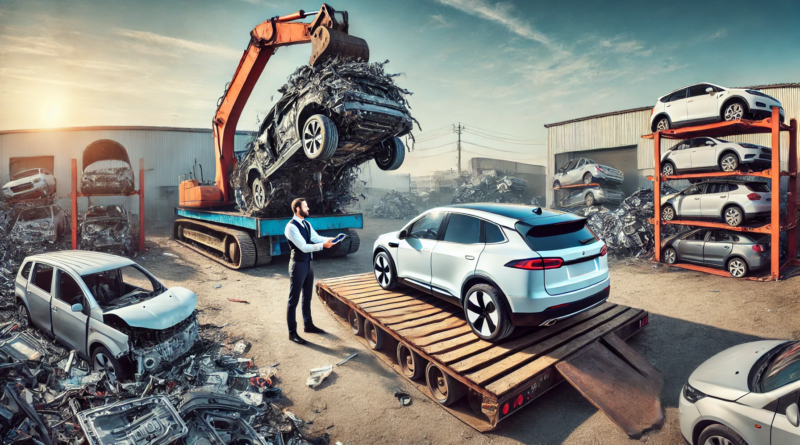Europe’s Decisive Decade: How Electric Vehicles Will Transform Continent By 2035
Support CleanTechnica's work through a Substack subscription or on Stripe.

Europe stands at the doorstep of a decisive decade for electric vehicles. Over the next ten years, the continent’s major automotive markets — Germany, France, Italy, Spain, and the Netherlands — will see battery-electric vehicles dominate new car sales. This shift is driven largely by strong policy mandates, technological improvements, and market dynamics that have finally aligned. The speed and scope of this transition reflect the classic logistic s-curve of technology adoption, which begins slowly, accelerates rapidly after reaching a critical tipping point, and eventually plateaus as the technology saturates the market.
This piece is part of an intermittent series of articles on the coming tipping points in EV adoption indicated by the complementary systems change observations of diffusion of innovations, logistic growth or the s-curve, and complex adaptive systems, introduced in the first article. The second dealt with changes when 5%-15% penetrations of EVs were reached, something already present in some markets. The third dealt with the critical 15%-40% range, when change is accelerating and the internal combustion services industry starts feeling the impacts. The fourth dealt with the next big transition, the 40%-80% range, when internal combustion service firms start shuttering en masse, requiring significant governmental assistance transitioning work forces. The next articles deal with regional variation, starting with Europe.
Looking ahead to the next decade, Europe’s sales figures for electric vehicles provide a clear illustration of the continent’s accelerating transition. By 2025, battery-electric cars alone will represent around 15 to 20% of new vehicle sales in Europe. Combined with plug-in hybrids, nearly a quarter of all new cars sold will have a plug. From this initial foothold, electric car adoption is set to accelerate steeply. By 2027, pure battery-electric models are projected to account for approximately 30 to 40% of new car sales. At this point, the broader electric market, including plug-in hybrids, could approach half of all new vehicles sold. Historical transitions, such as the adoption of smartphones or color television, show that once a new technology passes this level of adoption, growth typically accelerates much faster.
By 2030, the transformation becomes unmistakably clear. Battery-electric vehicles alone will make up about half of all new car sales in Europe, with total electrified vehicles reaching roughly 60%. This milestone aligns directly with Europe’s ambitious climate targets, particularly the EU’s policy of reducing fleet-wide vehicle CO₂ emissions by at least 55% compared to 2021 levels. Automakers across Europe are ramping up electric vehicle production dramatically, ensuring the supply will be there to meet these ambitious goals. In the UK, even more aggressive targets are set, aiming for 80% of new car sales to be zero-emission vehicles by 2030.
By 2035, Europe’s transition is essentially complete, at least in new vehicle sales. More than 90% of new cars sold in the European Union will be battery-electric vehicles. Plug-in hybrids will largely fade from the market, remaining only in small, specialized segments. At this stage, Europe’s regulations will effectively prohibit new internal combustion engine sales, leaving battery-electric as the dominant and nearly sole option available to consumers.
Despite these rapid sales transformations, fleet-wide penetration of electric vehicles will lag behind by several years. Cars typically last between 12 and 15 years, meaning it takes time for new sales to reshape the total fleet of vehicles on the road. In 2023, only about 2% of Europe’s 294 million passenger cars were fully electric. Even in leading nations like Germany, fully electric vehicles made up only around 3% of the total fleet. Norway provides a notable exception, with electric vehicles comprising nearly a quarter of all cars on the road in early 2024, driven by several years of very high electric vehicle sales.
By 2030, Europe’s vehicle fleet will look substantially different. Approximately 20% of all passenger vehicles on European roads will be electric, translating to around 50 million cars. Germany alone plans to have about 15 million electric vehicles by that time, roughly a third of its national fleet. The pace of fleet electrification depends heavily on how quickly older gasoline and diesel cars are retired, as well as how effectively second-hand electric vehicles circulate into lower-income markets. Policy measures such as scrappage incentives and low-emission zones in cities can accelerate this fleet transformation.
By 2035, electric vehicles are expected to make up nearly half of Europe’s passenger vehicle fleet. More optimistic projections even suggest the fleet share could reach about 50% by then, especially if current adoption trends accelerate further. Still, achieving full fleet electrification will require additional time beyond 2035. It is likely that gasoline and diesel cars sold up until the 2035 cut-off will remain on roads well into the 2040s. Policymakers may need to adopt additional measures to speed this fleet turnover, such as stricter emissions-based taxes or targeted incentives for replacing older combustion vehicles.
As Europe’s shift to electric vehicles accelerates, a critical policy challenge will be managing the fate of millions of used internal combustion engine vehicles. While new car sales in Europe will move decisively toward electric by 2035, many gasoline and diesel cars removed from European roads may simply be exported to developing countries. Without careful policy interventions, these exported vehicles could remain in use overseas for decades longer, undercutting global emissions-reduction goals.
Addressing this challenge requires coordinated regulations or export controls designed to limit the transfer of older, high-emission vehicles to countries with less stringent environmental policies. Policymakers might need to support vehicle recycling programs or establish standards requiring exported vehicles to meet minimum emissions or efficiency criteria. Without such measures, Europe risks merely shifting the emissions problem elsewhere, undermining the global climate benefits of its rapid transition to electric vehicles.
Significant regional disparities in electric vehicle adoption persist within Europe. Northern and Western European countries, including Norway, Sweden, Germany, and the Netherlands, have led in EV sales, driven by higher average incomes, stronger governmental incentives, and denser charging infrastructure. Norway, for example, already surpassed 80% battery-electric vehicle sales in 2024. In contrast, Southern and Eastern European nations such as Italy, Spain, and Poland have lagged far behind, due primarily to lower incomes, less generous incentives, and sparse charging networks. In 2023, countries like Poland and Croatia reported less than 5% electric vehicle sales, significantly behind their northern counterparts.
These regional differences are likely to narrow over the coming decade but will not disappear completely. By 2030, nations in Northern Europe could achieve electric vehicle shares in new sales nearing 80 to 90%, while southern and eastern regions might only reach about 50%. By 2035, the EU-wide ban on new internal combustion engine sales will force all member states toward a nearly 100% electric vehicle sales target. Southern and Eastern European countries may face rapid, late-stage surges to catch up. Policymakers will likely need targeted support measures to manage these transitions effectively, ensuring adequate infrastructure and affordability to avoid leaving certain regions behind.
The shift to electric vehicles carries major infrastructure implications for Europe. Existing gasoline and diesel fueling stations, along with traditional maintenance shops, face significant contraction. As electric vehicles reach about 15 to 20% fleet penetration, gasoline stations typically begin to lose profitability. Norway already provides an early example. Fuel stations across the country have removed gasoline pumps and replaced them with electric chargers. Similar shifts are anticipated elsewhere in Europe. Large oil companies like Shell and BP are already preparing for this future, rapidly deploying charging infrastructure alongside traditional fuel pumps.
Vehicle maintenance sectors will also undergo dramatic shifts. Electric vehicles are mechanically simpler, requiring fewer repairs and eliminating traditional maintenance like oil changes and exhaust system repairs. Auto service businesses that specialized in these services will need to adapt, retrain employees, and shift their focus toward electric-specific maintenance like battery diagnostics and software updates. Historical parallels to film camera labs or blacksmiths suggest many smaller, independent auto repair shops could close unless they successfully transition their business models.
Perhaps the most critical aspect of Europe’s transition is scaling up charging infrastructure. By 2030, Europe will need millions of public chargers, with estimates ranging from 3.5 million to as high as 8.8 million, significantly more than the approximately 630,000 available as of 2023. To achieve this, Europe must dramatically accelerate charger installation rates, possibly requiring over a million new public charging points installed annually in the late 2020s. EU policies already mandate high-speed charging stations every 60 kilometers along major highways by 2025, and significant public-private partnerships are rapidly expanding urban charging access.
The transition will inevitably increase Europe’s electricity consumption, though studies indicate this rise is manageable. By 2035, electric vehicle charging might represent around 3.5% of Europe’s total electricity demand, up from under 1% today. Smart-charging technologies and vehicle-to-grid integration can further mitigate grid stress, helping to balance supply and demand effectively.
Europe’s transition parallels historical technology shifts, such as the rapid adoption of cars over horses in the early twentieth century and mobile phones over landlines decades later. In each instance, infrastructure, consumer convenience, and policy incentives aligned to accelerate change much faster than initially predicted. The coming decade appears poised for a similar rapid and decisive shift toward electric vehicles across Europe.
Europe’s transition to electric vehicles is no longer in question. Instead, the relevant questions now focus on how smoothly and rapidly this transformation will occur. If historical precedents offer guidance, this change may happen even faster and more completely than current projections suggest, placing Europe at the forefront of global climate leadership and sustainable transportation policy. The coming years will prove decisive in securing an efficient, equitable transition that benefits every part of the continent.
 Sign up for CleanTechnica's Weekly Substack for Zach and Scott's in-depth analyses and high level summaries, sign up for our daily newsletter, and follow us on Google News!
Sign up for CleanTechnica's Weekly Substack for Zach and Scott's in-depth analyses and high level summaries, sign up for our daily newsletter, and follow us on Google News!
Have a tip for CleanTechnica? Want to advertise? Want to suggest a guest for our CleanTech Talk podcast? Contact us here.
Sign up for our daily newsletter for 15 new cleantech stories a day. Or sign up for our weekly one on top stories of the week if daily is too frequent.
CleanTechnica uses affiliate links. See our policy here.
CleanTechnica's Comment Policy

